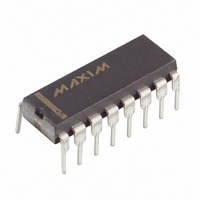DS1305N+ Maxim Integrated Products, DS1305N+ Datasheet - Page 11

DS1305N+
Manufacturer Part Number
DS1305N+
Description
IC RTC SERIAL ALARM 16-DIP
Manufacturer
Maxim Integrated Products
Type
Clock/Calendar/Alarmr
Datasheet
1.DS1305E.pdf
(22 pages)
Specifications of DS1305N+
Memory Size
96B
Time Format
HH:MM:SS (12/24 hr)
Date Format
YY-MM-DD-dd
Interface
SPI, 3-Wire Serial
Voltage - Supply
2 V ~ 5.5 V
Operating Temperature
-40°C ~ 85°C
Mounting Type
Through Hole
Package / Case
16-DIP (0.300", 7.62mm)
Function
Clock/Calendar/Alarm
Rtc Memory Size
96 Byte
Supply Voltage (max)
5.5 V
Supply Voltage (min)
2 V
Maximum Operating Temperature
+ 85 C
Minimum Operating Temperature
- 40 C
Mounting Style
Through Hole
Rtc Bus Interface
Serial (3-Wire, SPI)
Supply Current
1.28 mA
Lead Free Status / RoHS Status
Lead free / RoHS Compliant
SERIAL INTERFACE
The DS1305 offers the flexibility to choose between two serial interface modes. The DS1305 can
communicate with the SPI interface or with a standard 3-wire interface. The interface method used is
determined by the SERMODE pin. When this pin is connected to V
When this pin is connected to ground, standard 3-wire communication is selected.
SERIAL PERIPHERAL INTERFACE (SPI)
The serial peripheral interface (SPI) is a synchronous bus for address and data transfer, and is used when
interfacing with the SPI bus on specific Motorola microcontrollers such as the 68HC05C4 and the
68HC11A8. The SPI mode of serial communication is selected by tying the SERMODE pin to V
pins are used for the SPI. The four pins are the SDO (serial data out), SDI (serial data in), CE (chip
enable), and SCLK (serial clock). The DS1305 is the slave device in an SPI application, with the
microcontroller being the master.
The SDI and SDO pins are the serial data input and output pins for the DS1305, respectively. The CE
input is used to initiate and terminate a data transfer. The SCLK pin is used to synchronize data
movement between the master (microcontroller) and the slave (DS1305) devices.
The shift clock (SCLK), which is generated by the microcontroller, is active only during address and data
transfer to any device on the SPI bus. The inactive clock polarity is programmable in some
microcontrollers. The DS1305 determines the clock polarity by sampling SCLK when CE becomes
active. Therefore, either SCLK polarity can be accommodated. Input data (SDI) is latched on the internal
strobe edge and output data (SDO) is shifted out on the shift edge (Figure 5). There is one clock for each
bit transferred. Address and data bits are transferred in groups of eight, MSB first.
Figure 5. SERIAL CLOCK AS A FUNCTION OF MICROCONTROLLER CLOCK
POLARITY (CPOL)
CPOL = 0
CPOL = 1
NOTE 1: CPHA BIT POLARITY (IF APPLICABLE) MAY NEED TO BE SET ACCORDINGLY.
NOTE 2: CPOL IS A BIT THAT IS SET IN THE MICROCONTROLLER’S CONTROL REGISTER.
NOTE 3: SDO REMAINS AT HIGH-Z UNTIL 8 BITS OF DATA ARE READY TO BE SHIFTED OUT DURING A READ.
CE
SCLK
SCLK
SHIFT DATA OUT (READ)
SHIFT DATA OUT (READ)
11 of 22
CC
, SPI communication is selected.
DATA LATCH (WRITE)
DATA LATCH (WRITE)
CC
. Four













